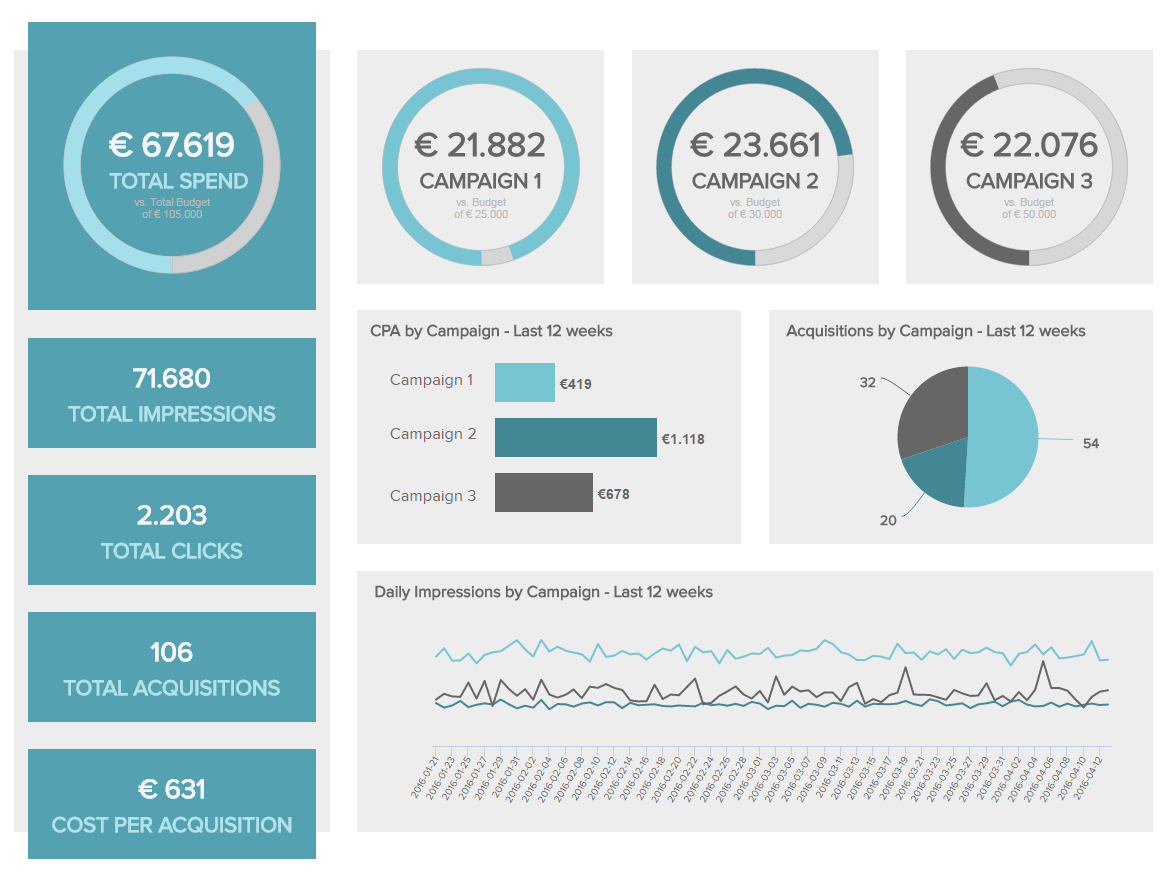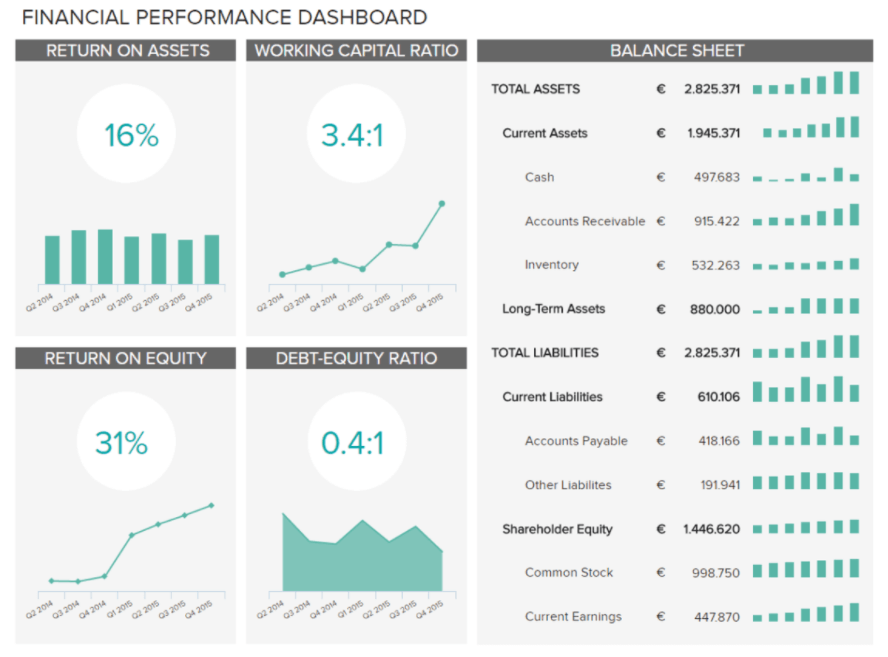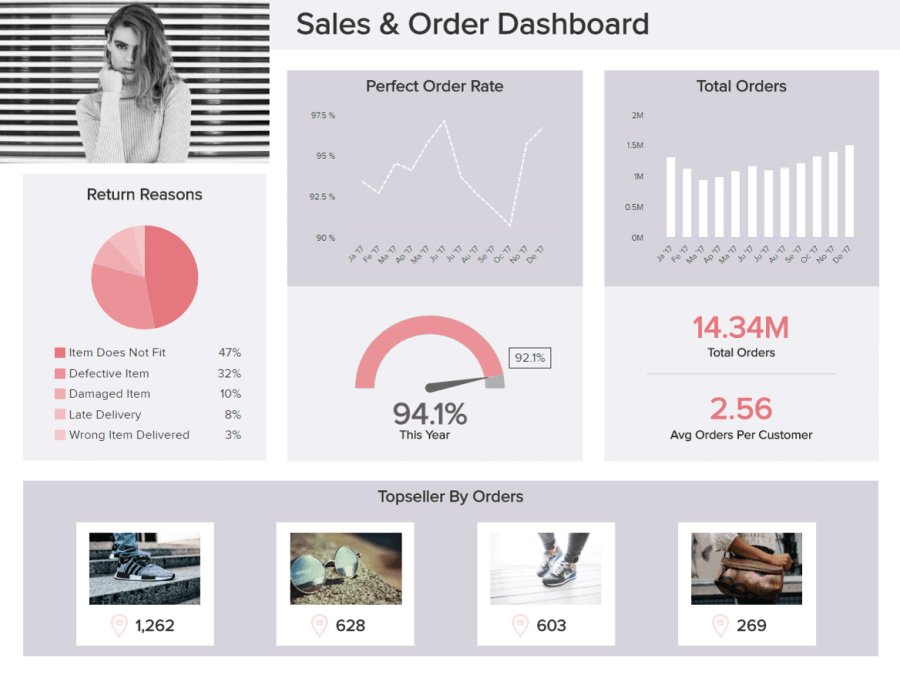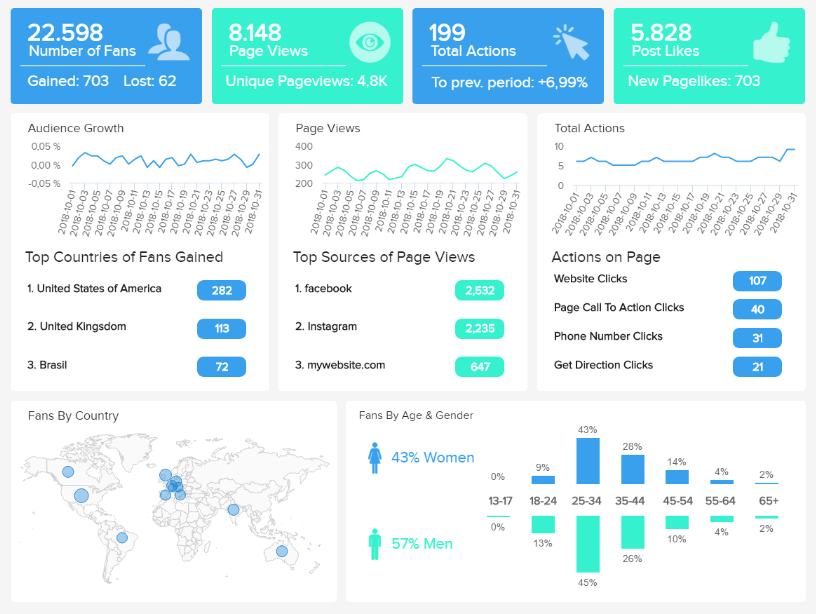Clik here to view.

To succeed in today’s competitive business world, the ability to make the right decisions at the right time based on water-tight insights is essential. If you don’t have the vision or don’t know what to do with it, you’ll find yourself shooting in the dark – and that is detrimental to the growth and evolution of any business, regardless of size or sector.
That said, if you’re looking to evolve your empire, increase brand awareness, and boost your bottom line, embracing business performance dashboards and big data should be at the top of your priority list. And we’re not just talking about a single function, but all your business’ bits and pieces should embrace the power of modern data analysis and utilize a professional dashboard creator that will enhance your data management processes.
Still unsure? Not to worry – we’ll not only explain the link between big data and business performance but also explore real-life performance dashboard examples and explain why you need one (or several).
What Is A Performance Dashboard In Business?
Clik here to view.
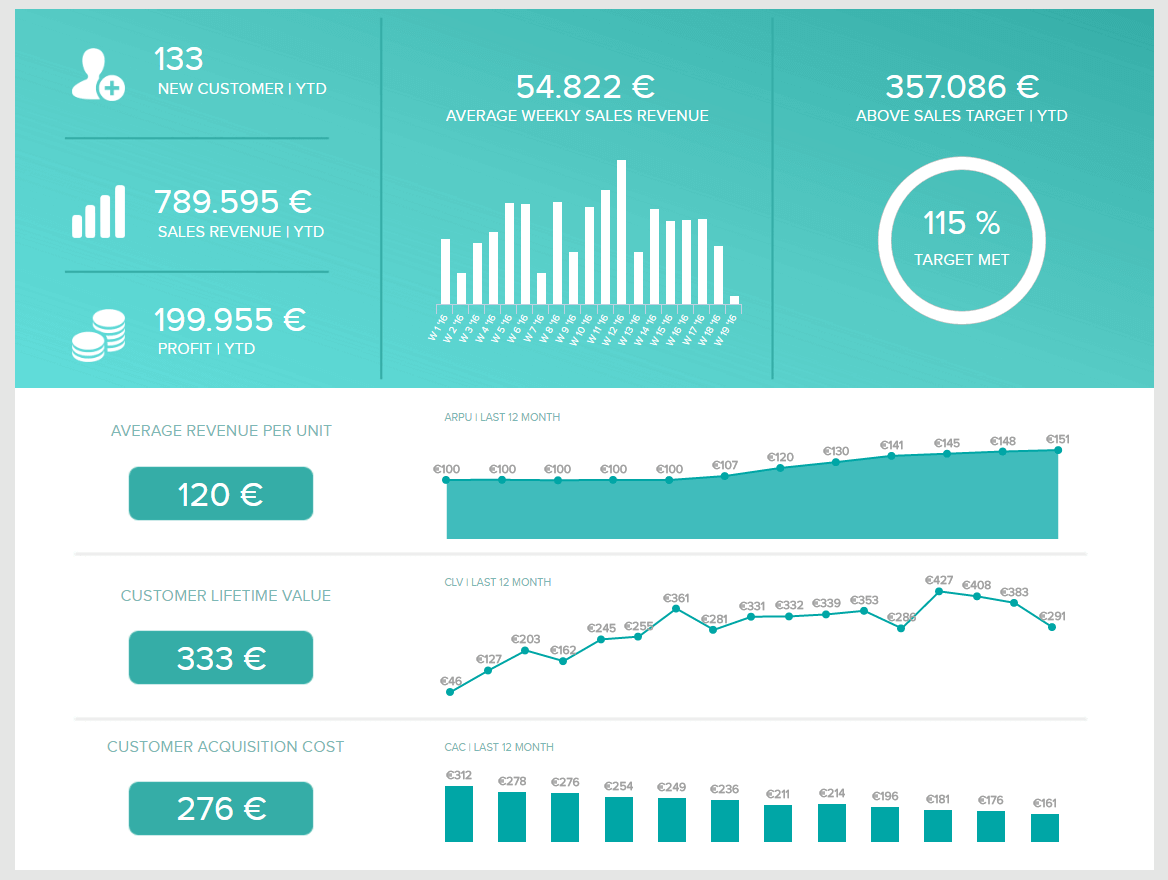
A performance dashboard is a data visualization tool that offers a wealth of knowledge on invaluable insights, enabling the user to gain a deeper understanding of their business’s performance in a number of areas while making valuable decisions that foster growth.
A product performance dashboard offers a wide range of information in one central location, allowing organizations to drill down into important product metrics and key performance indicators (KPIs) without the need to log in to separate tools or platforms but only a single dashboard software. It helps to easily spot the overall performance of product lines and adjust the quality, development of new products and evaluating existing ones.
Business performance dashboards assist in the cohesive rather than fragmented analysis of critical datasets, which ultimately results in sustainable commercial success in a competitive digital landscape.
The vast majority of business dashboards offer a customizable interface, a host of interactive features, and empower the user to extract real-time data from a broad spectrum of sources. This level of functionality presents a significant advantage over static dashboards, making business performance dashboards a key component to improved business intelligence (BI).
Business Performance Dashboard Examples
Another notable benefit of business performance dashboards is their self-service nature. Accessible, intuitive, and easy to navigate, it’s possible to use these invaluable online BI tools to their fullest potential without the need to rely on developers or technical staff.
In addition to this, a dashboard for business performance also builds confidence. The detailed, accurate, and digestible information served up by modern business performance management dashboards gives senior staff or personnel conviction when making decisions, which, in turn, will drive staff engagement while boosting success in a number of key organizational areas.
To put this notion into a living, breathing perspective, here are performance dashboard examples for your browsing pleasure.
1. Sales Performance Dashboard
Focusing on sales growth and profitability, this sales dashboard provides a panoramic overview of the sales department’s progress by drilling down deep into sales KPIs such as sales targets, ARPU (average revenue per unit), CAC (customer acquisition cost), and CLV (customer lifetime value).
**click to enlarge**
One of our most valuable performance dashboard templates, this is essentially a one-stop-shop for the sales insights that will help you iron out inefficiencies, enhance the performance of your sales team, and boost your profitability on a sustainable basis.
The goal here is to increase customer lifetime value and average revenue per unit or user/account while driving down acquisition costs – and the metrics served up here will help you meet these goals and maintain them over time. This example shows how the performance of the sales department can be viewed through a strong pipeline created with simple sales charts and combined in a dashboard. Whether you need to monitor performance on a weekly or strategic level, this kind of representation of data will ensure you stay focused on your most important KPIs, as mentioned. Moreover, you will visually see what happens and what can happen when you start interacting with your online data visualization creation that will, ultimately, secure top departmental performance.
Primary KPIs:
- Sales Growth
- Sales Target
- ARPU
- Acquisition Cost
- CLV
For more information on these business performance dashboard examples, explore our full range of sales dashboards.
2. Marketing Performance Dashboard
One of our pivotal marketing examples, this performance dashboard template has proved to be the beating heart of many successful organizations.
**click to enlarge**
Offering a comprehensive level of insight into critical marketing performance data across a multitude of marketing channels and campaigns, the dashboard will help you to create detailed marketing reports, and enjoy a maximum ROI for every one of your business’s promotional efforts. You can clearly see the general overview followed by the specific performance of each campaign you have launched. By gaining this wealth of knowledge in a clear and feasible way you can easily spot which campaign is the best performing one, which channels have the lowest cost-per-acquisition, and enable you to think about what steps you can take in your future promotional activities.
By delving into vital KPIs, including click-through rates, cost-per-click, and cost-per-acquisition, this priceless data dashboard will give you a greater understanding of the costs of your marketing efforts in comparison to your actual costs. Plus, metrics like click-through-rate will also help you gauge how engaging or effective specific marketing initiatives are, allowing you to make the tweaks necessary for optimal promotional success.
Primary KPIs:
- Click-Through-Rate (CTR)
- Cost-per-Click (CPC)
- Cost-per-Acquisition (CPA)
For more information on these business performance template examples, explore our full range of marketing dashboards.
3. Financial Performance Dashboard
The finance department of any organization, regardless of industry or sector, is vital to sustainable success and economic fluidity. This financial report example offers a robust snapshot of your company’s capital structure in addition to how your existing assets are being managed.
**click to enlarge**
This essential template closely monitors the two ratios (return on assets and return on equity) that will ensure you maintain control of your organization’s financial health on a continual basis, which, in turn, will not only help the business thrive but also give it the ability to deal with unexpected roadblocks or issues in a professional, productive manner.
The financial graphs depicted above prove how simple you can visualize all your company’s performance that is focused on capital and a general overview of the balance sheet. By closely inspecting these crucial financial indicators, you can immediately understand how your company’s assets are managed and adjust your strategies accordingly, if needed.
Primary KPIs:
- Return on Assets
- Return on Equity
For more information on our financial dashboard examples, explore our full range of financial dashboards.
4. Employee Performance Dashboard
It goes without saying (almost): your employees are the very people that make your organization tick, which means monitoring performance in this area is critical to your ongoing commercial success. And this most valuable of business performance dashboard templates will help you manage your staff the right way.
**click to enlarge**
Our HR dashboard example concentrated on employee performance, offers a host of information on key areas including attendance, productivity, overtime, training costs, and other critical areas in HR analytics. By gaining a deeper level of insight into these aspects of your employee’s performance, you will be able to spot trends, identify inefficiencies, and increase engagement where it might floundering. For example, you can indicate the level of motivation and engagement of your workers based on the absenteeism rate, and follow the numbers into the course of 5 years, as presented above. Additionally, you can measure employees’ productivity levels and tailor this indicator to your specific business needs such as letting people set their own working hours that will help them be as productive as possible.
With this online dashboard, you will gain the power to motivate and inspire your employees, provide training support in the right areas of the business, boost morale, drive down operational costs, and make strategic choices that will benefit both you and the people working within your organization.
Primary KPIs:
- Absenteeism Rate
- Overtime Hours
- Training Costs
- Employee Productivity
For more information on our employee performance, explore our full range of HR dashboard examples.
5. Support Team Performance Dashboard
Another crucial part of a successful business is the support team. That’s why a complete Zendesk dashboard will provide you with invaluable data on your team’s performance and give you instant insights and ideas on how to improve.
**click to enlarge**
Metrics such as the net promoter score, first contact resolution rate, occupancy rate, and top agents will ensure you monitor, visualize and analyze your performance in all relevant aspects of support operations that will improve your bottom line.
It is not a secret that customer service is the face of the company that needs to have a top-notch performance to be able to deliver results, ensure efficiency in utilizing call center KPIs that will, ultimately, increase profits. We can see in our example the first contact resolution rate that needs to be closely monitored alongside the average resolution and occupancy rate to see how they correlate and influence customer satisfaction. On the right side, we can see the top performing agents, an important indicator to see how your employees perform regarding the ticket status. When you identify these agents, you can also ask for additional education for each member of your department to see how to improve and implement their knowledge.
Primary KPIs
- Top Agents
- First Contact Resolution Rate
- Utilization Rate
- Net Promoter Score
6. Hospital Performance Dashboard
Improving the clinical and financial performance of a hospital is one of the top priorities in this important industry. A dashboard depicting crucial metrics such as the average length of stay, average nurse per patient ratio, and treatment costs will enable you to take full control of your hospital performance and ensure you can offer the best possible care to current and potential patients.
**click to enlarge**
By utilizing healthcare analytics software where you can set your KPIs and create a powerful dashboard, you can optimize your operations and increase the productivity of your hospital. Your patients and staff are the most important part of succeeding in the healthcare industry. You need to keep an optimal number of available staff to take care of patients and make sure you don’t overburden your employees. That way, your hospital won’t face issues in providing the best possible care. Smart alarms and automated reports provided with this dashboard will ensure smooth operational processes and effective hospital management. Besides, you can utilize ad hoc analysis and create reports based on standalone questions and adjust your dashboards accordingly.
By combining all these metrics and interacting with the dashboard, you will be able to monitor each important aspect of your hospital and generate insights instantaneously while keeping a close eye on finances, overall workload of your staff and patients’ satisfaction levels.
Primary KPIs
- Average Hospital Stay
- Hospital Readmission Rates
- Costs By Payer
7. Transportation Dashboard
In an age where consumers are more demanding than ever, optimizing your transportation processes and initiatives is essential.
**click to enlarge**
Ensuring that every aspect of the transportation chain is cohesive is vital to maintaining an optimal level of service while eliminating unnecessary costs and logistical roadblocks. And while this may seem like an impossible feat, it is more than possible in the digital age.
This performance dashboard is designed to improve delivery times while driving down transportation costs. Our cutting-edge logistics dashboard offers a clear-cut snapshot of destinations, delivery status, and loading times.
This perfect storm of visual information is a prime example of a dashboard to measure performance in business and will help busy logistics managers make informed decisions at a glance while creating strategies that will ultimately improve core service performance levels.
This is an essential performance metrics dashboard for any goods-based organization, big or small.
Primary KPIs:
- Delivery Time
- Transportation Costs
8. Sales & Order Overview Dashboard
A powerful retail-based performance monitoring dashboard, our sales and orders dashboard is a logical and visually balanced informational nerve center built to consistently improve performance.
**click to enlarge**
When it comes to sales and orders, consistency and strategy are key – and that’s exactly what this performance management dashboard delivers. Here, you benefit from essential retail insights surrounding order return reasons, perfect order rates, overall order number, best-sellers, regional sales, and a wealth of additional information in one central location.
This fluid mix of retail-based dashboard performance KPIs offers decision-makers the tools required to spot potential weaknesses, identify strengths, and make strategic moves that increase efficiency while driving down order returns and increasing sales. For example, if you notice in a retail KPI significant deviations or the same return reasons over and over, it makes sense to adjust your strategies accordingly and listen to what your customers have to say.
This is a product performance dashboard template that is insightful, actionable, and – if you’re a retail or eCommerce-based business – accelerates your success in a competitive commercial landscape.
Primary KPIs:
- Total Orders
- Total Sales by Region
- Order Status
- Perfect Order Rate
- Return Reason
9. Facebook Page Dashboard
Last but not least in our rundown of dynamic performance dashboard examples is our Facebook dashboard.
With over 2.7 billion monthly users worldwide, Facebook is still one of the planet’s most popular social media platforms. Regardless of your niche or sector, as a business in the digital age, knowing how to utilize the platform to your advantage will accelerate your business growth significantly.
**click to enlarge**
One of our most visually striking performance dashboards, this particular innovation offers a wealth of insight into Facebook’s most valuable metrics – information based on engagement, demographics, and regional interest.
By gaining access to this treasure trove of company performance dashboard metrics, you can gain a working understanding of the type of content that resonates most with your audience based on demographics, posting time, and region.
Armed with these visual Facebook metrics, senior decision-makers, and social media marketers can utilize this dashboard performance template to drive maximum engagement while enjoying a maximum return on investment (ROI) from the Facebook-based activities.
This is a performance review dashboard that will prove invaluable to every modern business looking to make its mark and use it as an invaluable social media report template.
Primary KPIs:
- Number of Fans
- Follower Demographics
- Page Views by Sources
- Actions on Page
“Without a systematic way to start and keep data clean, bad data will happen.” – Donato Diorio
How Do I Make A Performance Dashboard?
Clik here to view.

We’ve answered the question, ‘What is a performance dashboard’, and explored a mix of real-world examples. Now, it’s time to look at how to create a simple dashboard to measure performance, whether you need a TV dashboard for an office display or you want to present them on your desktop computer.
- Consider the end goal: Before you begin to build or design your business performance dashboard, understanding your core or end goal is essential. A business development dashboard typically assists with the decision-making process while uncovering potential trends or issues, so it’s important to first figure out what kind of data you need to analyze. Sit down in a collaborative environment with trusted colleagues and decide what you want your dashboards to help you achieve. This is an important part of the process and should not be overlooked.
- Curate and arrange your information: Now that you understand the primary purpose of your business performance management dashboard, you can start curating the data you will need to track, monitor, and visualize essential trends and insights. For instance, if you’re a retailer and want to know why people are returning your products or goods, you need to ensure that returns or refunds data and metrics are included as a central part of your dashboard. At this stage, you are beginning to paint a visual picture to work with.
- Set your key performance indicators: Once you know what your main aim is, and you’ve curated the types of data you will need to make your dashboard a success, you can bring your insights to life by setting the right KPIs. Modern performance dashboard templates are equipped with a host of dynamic and interactive visual KPIs that make it easy to extract vital information from a variety of sources at a single glance. Explore our range of interactive KPIs for inspiration.
- Design your dashboard: Whether you’re creating a product performance dashboard, an employee performance dashboard, a team performance dashboard, or anything in between, getting your design elements in place is essential. Without a cohesive design aligned to your specific needs and preferences, your dashboards will be confusing and inefficient. The good news is that modern data dashboards are fully customizable (without the need to be an IT professional) and 100% interactive. We’ve put together a dashboard design best practices tutorial to guide your efforts.
- Remain responsive: While modern data dashboards are dynamic and interactive, it’s essential that you remain responsive when creating your dashboards. In the age of information, the goalposts are always changing. As such, if you want to ensure your dashboard continues to present the information you need to remain responsive, committing to constant improvement is vital. By testing your dashboard regularly to ensure it is still relevant and optimized for superior performance, you will continue to grow with the ever-evolving landscape around you. When you produce a performance report, you need to do so with the understanding that, to some degree, you will need to keep tweaking or rewriting it. Keep this in mind, and you will push yourself ahead of the competition.
These points will help you to transform business performance management dashboard solutions from an idea into tangible, success-driving reality.
“We are moving slowly into an era where big data is the starting point, not the end.” – Pearl Zhu, data expert
Key Benefits Of Performance Dashboards
Clik here to view.

We’ve considered the question, ‘What is a performance dashboard,’ looked at how to build a dashboard, and explored a series of real-world examples. Now, it’s time to dive into the undeniable benefits of using these kinds of intuitive, interactive analysis tools and platforms.
1. Instant insights
Rather than having to wait days, weeks, or months for data reports, modern dashboards offer access to critical data-driven insights almost instantly. Moreover, a dashboard of this kind also provides a panoramic view of real-time information, allowing key stakeholders within the business to make swift decisions that will ultimately save time and money. Your dashboard doesn’t need to freeze in time. You have the possibility to look at the data immediately, set refresh intervals, and let the software do the arduous work.
2. Increased efficiency
By gaining access to detailed sets of visually digestible information from one central location, you’ll be able to make more informed decisions on a regular basis. Over time, this will result in an overall improvement to your business’s efficiency in the areas that matter most. Everyone in your team or important stakeholder can explore data on their own without the need to copy or send numerous files. You access only one location where you look for insights, reports, analysis, and monitor your performance. That way, the whole company can benefit from increased productivity
3. Progress monitoring
By setting KPIs that align with your business’s goals, aims, and aspirations, you’ll be able to evaluate your progress accurately and understand whether you’re meeting important milestones. And if you’re not, your dashboard will offer a wealth of insight into ways to make improvements that will help you do so. Choosing the right KPI is a different topic but you need to keep in mind to focus on a few that will drive actions towards improving your performance.
4. Interactivity
How many spreadsheets have you scrolled upon and lost hours of work in searching for the right information? With the help of business intelligence dashboards, you won’t need any manual work except utilizing numerous interactive features within your screen; from drill-downs to dynamic text boxes and images – no business question will remain unanswered. You can easily filter your dashboard with just a few clicks and immediately find the information you were looking for, without scrolling or manually calculating your data.
5. Access 24/7/365
The online nature of company performance dashboards enables you to have access to your data no matter the place or time, you just need Internet connectivity and you can log in to your account from a mobile device, desktop, or laptop. The development of cloud technology provides you with a secure data storage area where you don’t need special IT knowledge, the vendor takes care of updating and managing the software. Your IT department can focus on other important tasks while your data management and performance monitoring can be done by everyone in the company, no matter where they’re located.
6. Intelligent reporting
You need to report on your performance, no matter the industry or department you’re a part of. A business development dashboard ensures your reporting is on schedule each week, month, or any time interval you set while the data updates itself and you don’t need to think about writing numerous Word files, Excel sheets, or creating a PowerPoint presentation. You can share the report internally or externally, set groups of recipients, or give viewing rights to specific users. The automation will do the rest. You can explore numerous business report examples that can show you how to develop and set up a proper report structure.
7. Predicting the future
When you need to secure a beneficial and positive performance for your business, a business performance management dashboard will obtain advanced features such as predictive analytics. Often times, statistical analysis is done manually and takes a lot of business hours to complete and provide recommendations for the future. But what if you have the possibility to let the software do the calculations based on your inserted data points and utilize the forecast engine that will visualize your performance for the next time period? It seems like a question from the future but today that’s more than possible.
8. Smart alarms
Another benefit you can take full advantage of is the intelligent data alerts feature that dashboards of this kind will have incorporated. With neural network alerts and pattern recognition, you will get automatically notified when a business anomaly occurs, keeping your performance on a top-notch level and enabling you to act as soon as possible. That way you can easily focus on other tasks while the company performance dashboard will alert you if something happens.software for 14 days, completely free!
9. Business evolution
Earlier, we touched on the notion of remaining responsive in an ever-changing business landscape. Now, based on the very performance dashboard definition, it’s clear that in order to drive continual business success, you need the kind of tool that can change and scale with you. Perhaps one of the biggest benefits of these kinds of data dashboards is the fact that they will give you the insights, visualizations, and robust, customizable data analyst tools to move with the landscape around you, securing long-term success. And if you want to thrive in business, you have to be able to secure long-term growth. Utilize the right data and the right tools, and you’ll be able to do just that.
The Link Between Data And Business Performance
In the Age of Information, there is an undeniable link between online data analysis and organizational performance. By leveraging the insights, information, and metrics that are most valuable to your business, both internal and external, while understanding how to take meaningful actions from the data before you, it’s possible to ensure your business remains robust, resilient, and competitive.
All areas of your modern-day business – from supply chain success to improved reporting processes and communications, interdepartmental collaboration, and general organization innovation – can benefit significantly from the use of analytics, structured into a live dashboard that can improve your data management efforts. According to Accenture, 89% of business innovators believe that that big data analytics will revolutionize business operations in the same way as the World Wide Web. Moreover, 57% of enterprise organizations currently employ a chief data officer, another study conducted by MicroStrategy. If you need more information about the topic, you can learn more from our article that focuses on enterprise software.
You need to monitor your business performance and derive actionable insights. If you fail to do so, you risk damages in your productivity and costs. With the competitive market that your company faces, that can only bring danger to shut down your operations. That kind of gamble is not the path to success. You need data-driven decisions, and a dashboard for business performance will make sure you reap the best possible rewards.
It’s clear that big data, if used to its full potential, has the power to improve your organization’s operations and initiatives exponentially, and a performance dashboard is pivotal to squeezing every last drop of value from the data before you.
A performance-based dashboard provides unrivaled digital wisdom. When you use data in a way that makes sense in a real-world context (rather than just in theory), you will be able to drive change and make genuine improvements to your business. And that is the key concept of business-based performance dashboards.
Without data, you are just another person with an opinion.” – W. Edwards Deming
Data offers the level of vision needed to make your business more robust, agile, and efficient. To drive this key message home: business performance dashboards provide the brain and eyes that will ultimately allow you to process, analyze, and extract the value of that data for continual innovation and growth in a fast-paced world.
In today’s hyper-connected business age, that is priceless. We have seen that in our examples of how modern dashboards, created with self-service analytics tools, present data in a digestible format, easy to follow, and derive insights that will make your business faster, more agile, and more efficient.
Embrace the power of BI dashboards today, and you’ll reap endless rewards tomorrow. For more details on working with dynamic performance templates and using business intelligence the right way, you should try our modern software for a free, 14-day trial. Your path to data-driven enlightenment is just one click away.
The post Get Started With Business Performance Dashboards – Examples & Templates appeared first on BI Blog | Data Visualization & Analytics Blog | datapine.
